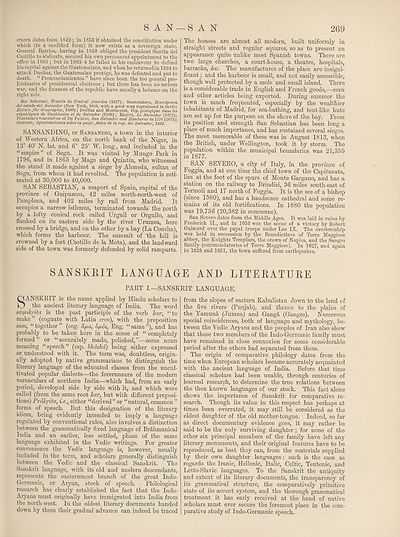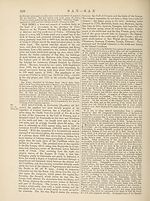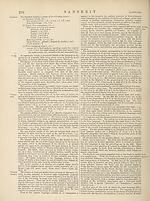Encyclopaedia Britannica > Volume 21, ROT-Siam
(279) Page 269
Download files
Complete book:
Individual page:
Thumbnail gallery: Grid view | List view

SAN
S A N-
crown dates from 1842 ; in 1853 it obtained the constitution under
which (in a modified form) it now exists as a sovereign state.
General Barrios, having in 1858 obliged the president Santin del
Castillo to abdicate, secured his own permanent appointment to the
office in 1860 ; but in 1863-4 he failed in his endeavour to defend
his capital against the Guatemalans, and when he returnedin 1864 to
attack Duenas, the Guatemalan protege, he was defeated and put to
death. “ Pronunciamientos ” have since been the too general pre¬
liminaries of presidential elections ; but there has been no serious
war, and the finances of the republic have usually a balance on the
right side.
Se.e Scherzer, Travels in Central America (1857) ; Sonnenstevn, Description
del ettado del Salvador (New York, 1859, with a good map reproduced in Berlin
Zeitsch. filr Geographic, 1860) ; Dolifus and Montserrat, Voy. geologique dans les
republiques de Guatemala et de Salvador (1868); Blairet, Le Salvador (1872);
Frantzius’s translation of De Palacio, San Salvador and Honduras in 1576 (1873)’;
Guzman, Apuntamientos sobre la geogr. fisica de la rep. del Salvador, 1883.
SANSANDING, or Sansandig, a town in the interior
of Western Africa, on the north bank of the Niger, in
13° 40' N. lat. and 6° 25' W. long., and included in the
“empire” of Segu. It was visited by Mungo Park in
1796, and in 1865 by Mage and Quintin, who witnessed
the stand it made against a siege by Ahmedu, sultan of
Segu, from whom it had revolted. The population is esti¬
mated at 30,000 to 40,000.
SAN SEBASTIAN, a seaport of Spain, capital of the
province of Guipuzcoa, 42 miles north-north-west of
Pamplona, and 402 miles by rail from Madrid. It
occupies a narrow isthmus, terminated towards the uorth
by a lofty conical rock called Urgull or Orgullo, and
flanked on its eastern side by the river Urumea, here
crossed by a bridge, and on the other by a bay (La Concha),
which forms the harbour. The summit of ‘the hill is
crowned by a fort (Castillo de la Mota), and the landward
side of the town was formerly defended by solid ramparts.
269
The houses are almost all modern, built uniformly in
straight streets and regular squares, so as to present an
appearance quite unlike most Spanish towns. There are
two large churches, a court-house, a theatre, hospitals,
barracks, &c. The manufactures of the place are insigni¬
ficant ; and the harbour is small, and not easily accessible,
though well protected by a mole and small island. There
is a considerable trade in English and French goods,—corn
and other articles being exported. During summer the
town is much frequented, especially by the wealthier
inhabitants of Madrid, for sea-bathing, and tent-like huts
are set up for the purpose on the shore of the bay. From
its position and strength San Sebastian has been long a
place of much importance, and has sustained several sieges.
The most memorable of these was in August 1813, when
the British, under Wellington, took it by storm. The
population within the municipal boundaries was 21,355
in 1877.
SAN SEVERO, a city of Italy, in the province of
Foggia, and at one time the chief town of the Capitanata,
lies at the foot of the spurs of Monte Gargano, and has a
station on the railway to Brindisi, 36 miles south-east of
Termoli and 17 north of Foggia. It is the see of a bishop
(since 1580), and has a handsome cathedral and some re¬
mains of its old fortifications. In 1880 the population
was 19,756 (20,382 in commune).
San Severo dates from the Middle Ages. It was laid in ruins by
Frederick II., and in 1053 was the scene of a victory by liobert
Guiscard over the papal troops under Leo IX. The overlordship
was held in succession by the Benedictines of Torre Maggiore
abbey, the Knights Templars, the crown of Naples, and the Sangro
family (commendatories of Torre Maggiore). In 1627, and again
in 1828 and 1851, the town suffered from earthquakes.
SANSKRIT LANGUAGE AND LITERATURE
PART I.—SANSKRIT LANGUAGE.
SANSKRIT is the name applied by Hindu scholars to
the ancient literary language of India. The word
samsh-ita is the past participle of the verb kar, “to
make ” (cognate with Latin creo), with the preposition
sam, “ together ” (cog. a/ia, o/aos, Eng. “ same ”), and has
probably to be taken here in the sense of “ completely
formed” or “accurately made, polished,”—some noun
meaning “speech” (esp. bhdshd) being either expressed
or understood with it. The term was, doubtless, origin¬
ally adopted by native grammarians to distinguish the
literary language of the educated classes from the uncul¬
tivated popular dialects—the forerunners of the modern
vernaculars of northern India—which had, from an early
period, developed side by side with it, and which were
called (from the same root Jcar, but with different preposi¬
tions) iVd/rrfifa, i.e., either “derived” or “natural, common”
forms of speech. But this designation of the literary
idiom, being evidently intended to imply a language
regulated by conventional rules, also involves a distinction
between the grammatically fixed language of Brahmanical
India and an earlier, less settled, phase of the same
language exhibited in the Vedic writings. For greater
convenience the Yedic language is, however, usually
included in the term, and scholars generally distinguish
between the Yedic and the classical Sanskrit. The
Sanskrit language, with its old and modern descendants,
represents the easternmost branch of the great Indo-
Germanic, or Aryan, stock of speech. Philological
research has clearly established the fact that the Indo-
Aryans must originally have immigrated into India from
the north-west. In the oldest literary documents handed
down by them their gradual advance can indeed be traced
from the slopes of eastern Kabulistan down to the land of
the five rivers (Punjab), and thence to the plains of
the A^amuna (Jumna) and Gangfi (Ganges). Numerous
special coincidences, both of language and mythology, be¬
tween the Vedic Aryans and the peoples of Iran also show
that these two members of the Indo-Germanic family must
have remained in close connexion for some considerable
period after the others had separated from them.
The origin of comparative philology dates from the
time when European scholars became accurately acquainted
with the ancient language of India. Before that time
classical scholars had been unable, through centuries of
learned research, to determine the true relations between
the then known languages of our stock. This fact alone
showrs the importance of Sanskrit for comparative re¬
search. Though its value in this respect has perhaps at
times been overrated, it may still be considered as the
eldest daughter of the old mother-tongue. Indeed, so far
as direct documentary evidence goes, it may rather be
said to be the only surviving daughter; for none of the
other six principal members of the family have left any
literary monuments, and their original features have to be
reproduced, as best they can, from the materials supplied
by their own daughter languages: such is the case as
regards the Iranic, Hellenic, Italic, Celtic, Teutonic, and
Letto-Slavic languages. To the Sanskrit the antiquity
and extent of its literary documents, the transparency of
its grammatical structure, the comparatively primitive
state of its accent system, and the thorough grammatical
treatment it has early received at the hand of native
scholars must ever secure the foremost place in the com¬
parative study of Indo-Germanic speech.
S A N-
crown dates from 1842 ; in 1853 it obtained the constitution under
which (in a modified form) it now exists as a sovereign state.
General Barrios, having in 1858 obliged the president Santin del
Castillo to abdicate, secured his own permanent appointment to the
office in 1860 ; but in 1863-4 he failed in his endeavour to defend
his capital against the Guatemalans, and when he returnedin 1864 to
attack Duenas, the Guatemalan protege, he was defeated and put to
death. “ Pronunciamientos ” have since been the too general pre¬
liminaries of presidential elections ; but there has been no serious
war, and the finances of the republic have usually a balance on the
right side.
Se.e Scherzer, Travels in Central America (1857) ; Sonnenstevn, Description
del ettado del Salvador (New York, 1859, with a good map reproduced in Berlin
Zeitsch. filr Geographic, 1860) ; Dolifus and Montserrat, Voy. geologique dans les
republiques de Guatemala et de Salvador (1868); Blairet, Le Salvador (1872);
Frantzius’s translation of De Palacio, San Salvador and Honduras in 1576 (1873)’;
Guzman, Apuntamientos sobre la geogr. fisica de la rep. del Salvador, 1883.
SANSANDING, or Sansandig, a town in the interior
of Western Africa, on the north bank of the Niger, in
13° 40' N. lat. and 6° 25' W. long., and included in the
“empire” of Segu. It was visited by Mungo Park in
1796, and in 1865 by Mage and Quintin, who witnessed
the stand it made against a siege by Ahmedu, sultan of
Segu, from whom it had revolted. The population is esti¬
mated at 30,000 to 40,000.
SAN SEBASTIAN, a seaport of Spain, capital of the
province of Guipuzcoa, 42 miles north-north-west of
Pamplona, and 402 miles by rail from Madrid. It
occupies a narrow isthmus, terminated towards the uorth
by a lofty conical rock called Urgull or Orgullo, and
flanked on its eastern side by the river Urumea, here
crossed by a bridge, and on the other by a bay (La Concha),
which forms the harbour. The summit of ‘the hill is
crowned by a fort (Castillo de la Mota), and the landward
side of the town was formerly defended by solid ramparts.
269
The houses are almost all modern, built uniformly in
straight streets and regular squares, so as to present an
appearance quite unlike most Spanish towns. There are
two large churches, a court-house, a theatre, hospitals,
barracks, &c. The manufactures of the place are insigni¬
ficant ; and the harbour is small, and not easily accessible,
though well protected by a mole and small island. There
is a considerable trade in English and French goods,—corn
and other articles being exported. During summer the
town is much frequented, especially by the wealthier
inhabitants of Madrid, for sea-bathing, and tent-like huts
are set up for the purpose on the shore of the bay. From
its position and strength San Sebastian has been long a
place of much importance, and has sustained several sieges.
The most memorable of these was in August 1813, when
the British, under Wellington, took it by storm. The
population within the municipal boundaries was 21,355
in 1877.
SAN SEVERO, a city of Italy, in the province of
Foggia, and at one time the chief town of the Capitanata,
lies at the foot of the spurs of Monte Gargano, and has a
station on the railway to Brindisi, 36 miles south-east of
Termoli and 17 north of Foggia. It is the see of a bishop
(since 1580), and has a handsome cathedral and some re¬
mains of its old fortifications. In 1880 the population
was 19,756 (20,382 in commune).
San Severo dates from the Middle Ages. It was laid in ruins by
Frederick II., and in 1053 was the scene of a victory by liobert
Guiscard over the papal troops under Leo IX. The overlordship
was held in succession by the Benedictines of Torre Maggiore
abbey, the Knights Templars, the crown of Naples, and the Sangro
family (commendatories of Torre Maggiore). In 1627, and again
in 1828 and 1851, the town suffered from earthquakes.
SANSKRIT LANGUAGE AND LITERATURE
PART I.—SANSKRIT LANGUAGE.
SANSKRIT is the name applied by Hindu scholars to
the ancient literary language of India. The word
samsh-ita is the past participle of the verb kar, “to
make ” (cognate with Latin creo), with the preposition
sam, “ together ” (cog. a/ia, o/aos, Eng. “ same ”), and has
probably to be taken here in the sense of “ completely
formed” or “accurately made, polished,”—some noun
meaning “speech” (esp. bhdshd) being either expressed
or understood with it. The term was, doubtless, origin¬
ally adopted by native grammarians to distinguish the
literary language of the educated classes from the uncul¬
tivated popular dialects—the forerunners of the modern
vernaculars of northern India—which had, from an early
period, developed side by side with it, and which were
called (from the same root Jcar, but with different preposi¬
tions) iVd/rrfifa, i.e., either “derived” or “natural, common”
forms of speech. But this designation of the literary
idiom, being evidently intended to imply a language
regulated by conventional rules, also involves a distinction
between the grammatically fixed language of Brahmanical
India and an earlier, less settled, phase of the same
language exhibited in the Vedic writings. For greater
convenience the Yedic language is, however, usually
included in the term, and scholars generally distinguish
between the Yedic and the classical Sanskrit. The
Sanskrit language, with its old and modern descendants,
represents the easternmost branch of the great Indo-
Germanic, or Aryan, stock of speech. Philological
research has clearly established the fact that the Indo-
Aryans must originally have immigrated into India from
the north-west. In the oldest literary documents handed
down by them their gradual advance can indeed be traced
from the slopes of eastern Kabulistan down to the land of
the five rivers (Punjab), and thence to the plains of
the A^amuna (Jumna) and Gangfi (Ganges). Numerous
special coincidences, both of language and mythology, be¬
tween the Vedic Aryans and the peoples of Iran also show
that these two members of the Indo-Germanic family must
have remained in close connexion for some considerable
period after the others had separated from them.
The origin of comparative philology dates from the
time when European scholars became accurately acquainted
with the ancient language of India. Before that time
classical scholars had been unable, through centuries of
learned research, to determine the true relations between
the then known languages of our stock. This fact alone
showrs the importance of Sanskrit for comparative re¬
search. Though its value in this respect has perhaps at
times been overrated, it may still be considered as the
eldest daughter of the old mother-tongue. Indeed, so far
as direct documentary evidence goes, it may rather be
said to be the only surviving daughter; for none of the
other six principal members of the family have left any
literary monuments, and their original features have to be
reproduced, as best they can, from the materials supplied
by their own daughter languages: such is the case as
regards the Iranic, Hellenic, Italic, Celtic, Teutonic, and
Letto-Slavic languages. To the Sanskrit the antiquity
and extent of its literary documents, the transparency of
its grammatical structure, the comparatively primitive
state of its accent system, and the thorough grammatical
treatment it has early received at the hand of native
scholars must ever secure the foremost place in the com¬
parative study of Indo-Germanic speech.
Set display mode to:
![]() Universal Viewer |
Universal Viewer | ![]() Mirador |
Large image | Transcription
Mirador |
Large image | Transcription
Images and transcriptions on this page, including medium image downloads, may be used under the Creative Commons Attribution 4.0 International Licence unless otherwise stated. ![]()
| Encyclopaedia Britannica > Encyclopaedia Britannica > Volume 21, ROT-Siam > (279) Page 269 |
|---|
| Permanent URL | https://digital.nls.uk/193630906 |
|---|
| Attribution and copyright: |
|
|---|---|
| Shelfmark | EB.17 |
|---|---|
| Description | Ten editions of 'Encyclopaedia Britannica', issued from 1768-1903, in 231 volumes. Originally issued in 100 weekly parts (3 volumes) between 1768 and 1771 by publishers: Colin Macfarquhar and Andrew Bell (Edinburgh); editor: William Smellie: engraver: Andrew Bell. Expanded editions in the 19th century featured more volumes and contributions from leading experts in their fields. Managed and published in Edinburgh up to the 9th edition (25 volumes, from 1875-1889); the 10th edition (1902-1903) re-issued the 9th edition, with 11 supplementary volumes. |
|---|---|
| Additional NLS resources: |
|

